
Filter News
Area of Research
- (-) Materials for Computing (12)
- (-) National Security (11)
- (-) Neutron Science (80)
- Advanced Manufacturing (9)
- Biology and Environment (34)
- Building Technologies (2)
- Computational Biology (1)
- Computational Engineering (1)
- Computer Science (5)
- Energy Science (78)
- Energy Sciences (2)
- Fusion and Fission (21)
- Fusion Energy (10)
- Isotopes (5)
- Materials (59)
- Nuclear Science and Technology (29)
- Nuclear Systems Modeling, Simulation and Validation (1)
- Quantum information Science (1)
- Supercomputing (37)
- Transportation Systems (1)
News Type
News Topics
- (-) Big Data (7)
- (-) Energy Storage (7)
- (-) Materials Science (20)
- (-) Neutron Science (79)
- (-) Nuclear Energy (4)
- (-) Space Exploration (2)
- 3-D Printing/Advanced Manufacturing (6)
- Artificial Intelligence (11)
- Bioenergy (6)
- Biology (6)
- Biomedical (12)
- Biotechnology (1)
- Buildings (1)
- Chemical Sciences (5)
- Clean Water (2)
- Computer Science (21)
- Coronavirus (10)
- Cybersecurity (9)
- Environment (8)
- Fossil Energy (1)
- Grid (5)
- High-Performance Computing (4)
- Hydropower (1)
- Machine Learning (11)
- Materials (17)
- Mathematics (1)
- Microscopy (5)
- Nanotechnology (10)
- National Security (23)
- Partnerships (1)
- Physics (2)
- Polymers (3)
- Quantum Computing (1)
- Quantum Science (4)
- Security (6)
- Simulation (1)
- Summit (3)
- Transportation (6)
Media Contacts

A study by researchers at the ORNL takes a fresh look at what could become the first step toward a new generation of solar batteries.
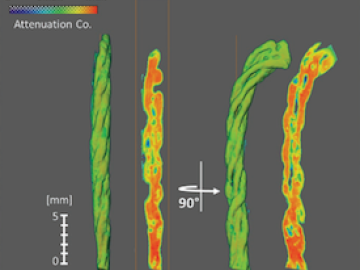
Textile engineering researchers from North Carolina State University used neutrons at Oak Ridge National Laboratory to identify a special wicking mechanism in a type of cotton yarn that allows the fibers to control the flow of liquid across certain strands.
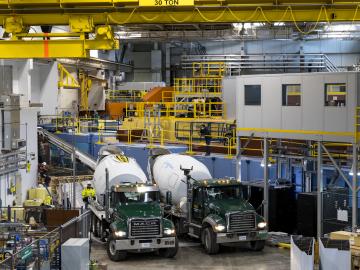
Cement trucks entering and exiting the Spallation Neutron Source are a common sight as construction of the VENUS neutron imaging beamline progresses. Slated for completion and commissioning in 2024-2025, VENUS is the twentieth neutron instrument at SNS and will offer many new capabilities.

A discovery by Oak Ridge National Laboratory researchers may aid the design of materials that better manage heat.

A team led by the U.S. Department of Energy’s Oak Ridge National Laboratory demonstrated the viability of a “quantum entanglement witness” capable of proving the presence of entanglement between magnetic particles, or spins, in a quantum material.
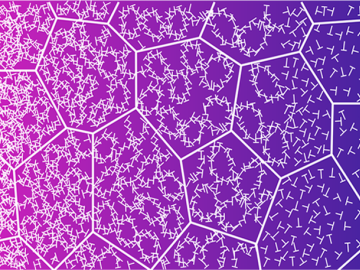

Oak Ridge National Laboratory researchers have developed a new catalyst for converting ethanol into C3+ olefins – the chemical
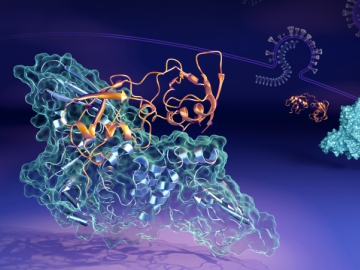
Scientists at Oak Ridge National Laboratory have uncovered how the SARS-CoV-2 virus evades the human immune system by studying the interaction between a viral protein (PLpro) and a key immune protein (ISG15). These insights could guide the development of therapeutic drugs to block this interaction, enhancing the body’s ability to combat the virus.

An ORNL-led team comprising researchers from multiple DOE national laboratories is using artificial intelligence and computational screening techniques – in combination with experimental validation – to identify and design five promising drug therapy approaches to target the SARS-CoV-2 virus.
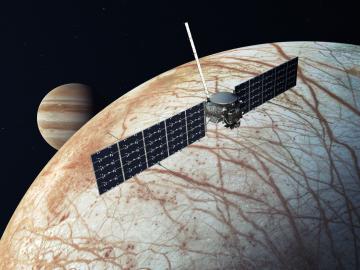
Researchers from NASA’s Jet Propulsion Laboratory and Oak Ridge National Laboratory successfully created amorphous ice, similar to ice in interstellar space and on icy worlds in our solar system. They documented that its disordered atomic behavior is unlike any ice on Earth.


